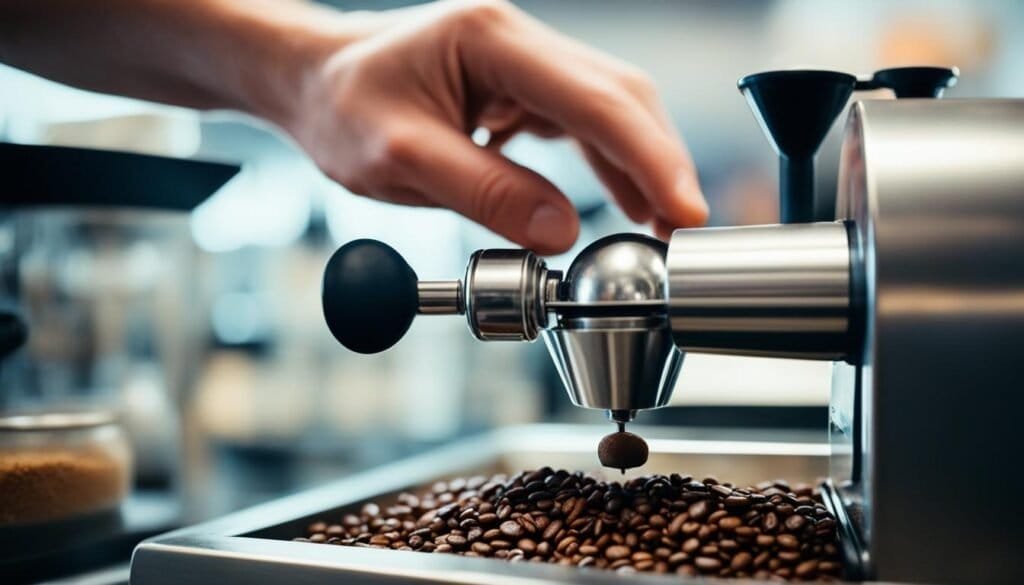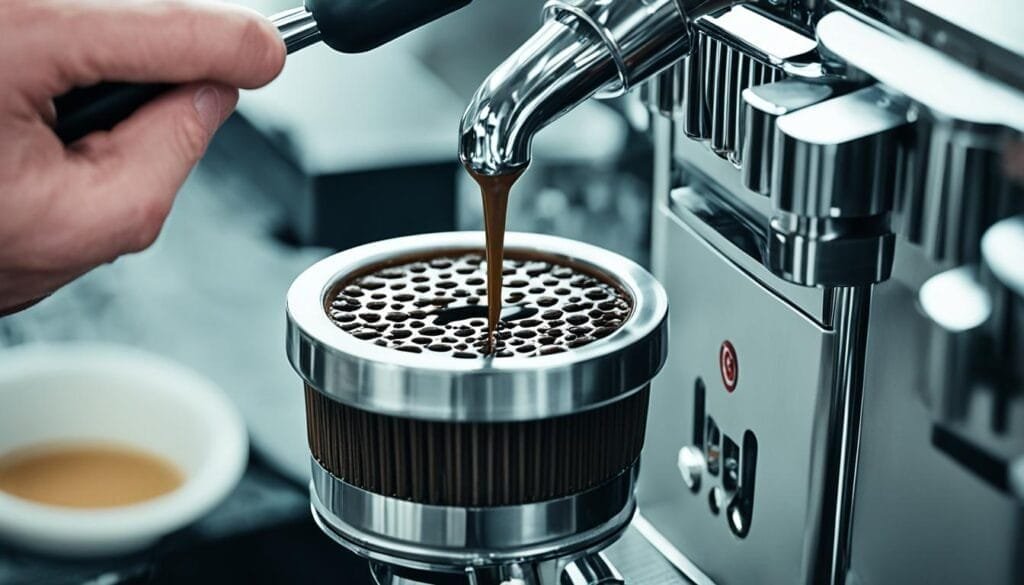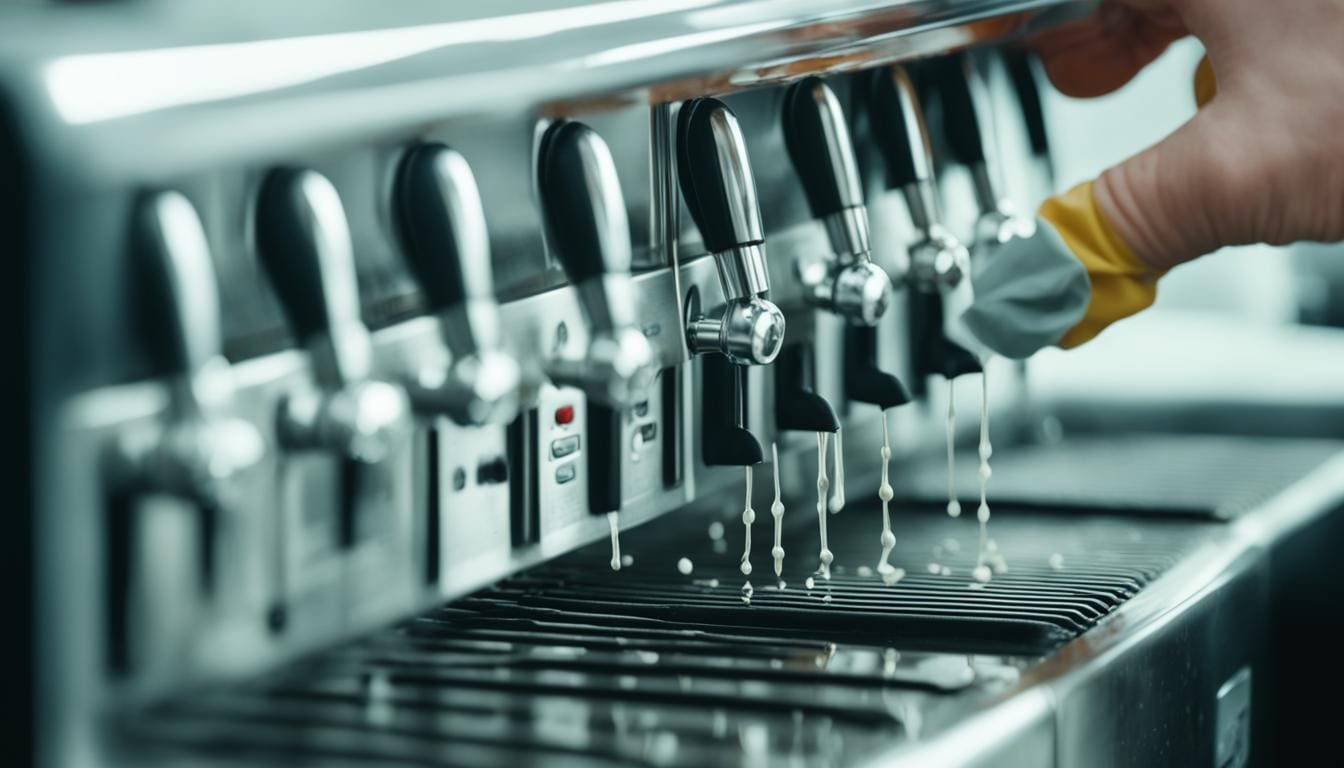Did you know that 80% of the flavor in your coffee is determined by the cleanliness of your coffee equipment? It’s not just about brewing methods and coffee quality; proper barista cleaning techniques play a crucial role in the taste and aroma of your cup of joe.
As a skilled barista, you understand the importance of maintaining impeccable hygiene in your coffee shop. From deep cleaning your espresso machine to sanitizing your barista equipment, mastering advanced barista cleaning techniques is essential for elevating your coffee craft.
In this comprehensive guide, we will explore the best practices for barista cleanliness, including coffee machine maintenance, deep cleaning espresso machines, and coffee shop hygiene practices. Get ready to take your barista skills to the next level with these advanced cleaning methods.
Key Takeaways:
- Proper barista cleaning techniques significantly impact the flavor and quality of your coffee.
- Mastering advanced barista cleaning methods is vital for maintaining coffee equipment longevity.
- Coffee machine maintenance and deep cleaning practices are essential for optimal performance.
- Sanitizing barista equipment ensures compliance with hygiene standards and customer satisfaction.
- Implementing best practices for barista cleanliness contributes to the overall coffee shop experience.
Basic Coffee Knowledge
Before diving into the specifics of barista cleaning, it is crucial to have a solid foundation of basic coffee knowledge. Understanding the fundamentals of coffee flavor profiles, production and processing methods, as well as coffee extraction and brewing techniques, is essential for a barista to provide a superior coffee experience to customers.
Coffee Flavor Profiles:
Every coffee has a unique flavor profile that can be categorized into different taste profiles such as fruity, nutty, chocolatey, or floral. By understanding these flavor profiles, baristas can recommend and serve coffee that suits individuals’ preferences.
Coffee Production and Processing:
Coffee production involves a series of steps from growing and harvesting coffee cherries to processing and drying the beans. Different regions and processing methods contribute to the distinct characteristics of coffee. Baristas should familiarize themselves with the various coffee origins and processing techniques to better communicate the coffee’s story to customers.
Coffee Extraction and Brewing Techniques:
The science of coffee extraction involves understanding the variables that affect the extraction process, such as water temperature, grind size, and brew time. Baristas should be knowledgeable about different brewing methods like pour-over, espresso, French press, and AeroPress, and be able to recommend the most suitable method for different coffee beans.
| Flavor Profile | Description |
|---|---|
| Fruity | Coffees with fruity flavor notes, such as berries or citrus. |
| Nutty | Coffees with nutty flavor notes, like almonds or hazelnuts. |
| Chocolatey | Coffees with rich, chocolatey flavor notes. |
| Floral | Coffees with floral aromas and flavors, often reminiscent of flowers. |
Quote:
“Basic coffee knowledge provides the groundwork for brewing exceptional coffee. Understanding flavor profiles, production methods, and extraction techniques allows baristas to curate a remarkable coffee experience for customers.”
By having a solid understanding of basic coffee knowledge, baristas can enhance their ability to choose the right beans, extract the desired flavors, and create remarkable coffee beverages. With a strong foundation, the journey to mastering advanced barista cleaning techniques becomes even more rewarding.
Grinding
Grinding is an essential step in the pursuit of exceptional coffee. As a barista, you must understand the significance of grinding fresh coffee beans just before brewing to preserve the flavor and prevent staleness. The grind size plays a crucial role in developing the desired taste and aroma in different brewing methods. The finer the grind size, the faster the extraction process and the slower the water flow, resulting in a distinct flavor profile.
To achieve consistent grind quality, it is essential to calibrate your espresso machine grinder. Calibration ensures that the grind size remains accurate, delivering optimal extraction each time. By fine-tuning your grinder, you can achieve the perfect balance between extraction time and water contact, allowing the flavors to fully develop.
Espresso Machine Grinder Calibration
Calibrating your espresso machine grinder requires precision and attention to detail. Start by adjusting the grind size to the recommended setting for your espresso machine. Then, pull a few shots and analyze the extraction time, taste, and visual cues. If the extraction is too fast, resulting in an under-extracted and sour espresso, adjust the grind to make it finer. Conversely, if the extraction is too slow, leading to an over-extracted and bitter espresso, adjust the grind to make it coarser.
Pro Tip: Use an espresso refractometer to objectively measure the TDS (Total Dissolved Solids) percentage in your espresso. This allows you to fine-tune the grind size and extraction parameters for optimum results.
Continue making small adjustments to the grind size while evaluating the extraction until you achieve the desired balance of flavors. Remember to make only minor adjustments at a time to avoid drastic changes that can throw off the extraction.
| Grind Size | Brewing Method | Extraction Profile |
|---|---|---|
| Coarse | French Press, Cold Brew | Bold and heavy-bodied |
| Medium | Pour-over, Drip Coffee | Bright and balanced |
| Fine | Espresso, Aeropress | Rich and full-bodied |
Understanding grind size and mastering espresso machine grinder calibration are crucial skills for any barista aspiring to create exceptional coffee. By honing your grinding techniques, you can unlock the full potential of your coffee beans and craft extraordinary coffee experiences for your customers.

Espresso-making
When it comes to creating the perfect espresso, mastering the art of espresso-making is essential. This process involves precise tamping techniques, maintaining the espresso machine’s functionality through regular maintenance, and understanding the various espresso-based drinks and their preparation methods.
Tamping
Tamping is the process of evenly compressing the coffee grounds in the portafilter to ensure a consistent extraction and balanced flavor in every shot of espresso. Proper tamping requires applying just the right amount of pressure, creating a uniform surface for the water to pass through. This technique prevents channeling, which leads to under or over-extraction and affects the taste of the coffee.
Espresso Machine Maintenance
To achieve optimal espresso quality and longevity of your espresso machine, regular maintenance is crucial. This includes cleaning the group heads, steam wands, and portafilters to remove any leftover coffee grounds, oils, or milk residue that can impact the flavor and performance of your espresso machine. It’s also essential to descale the machine regularly to remove mineral buildup and ensure consistent water flow.
Espresso-Based Drink Preparation
As a barista, it’s important to be well-versed in the various espresso-based drinks and their specific preparation methods. From classic shots of espresso and macchiatos to lattes and cappuccinos, each drink requires specific ratios of espresso, steamed milk, and foam. Understanding the differences in preparation allows you to deliver exceptional beverages that cater to your customers’ preferences.
Proper espresso-making involves a combination of skill, knowledge, and attention to detail. By mastering the art of tamping, maintaining the espresso machine, and understanding the preparation methods for different espresso-based drinks, you’ll be able to consistently create high-quality espresso and delight your customers with each sip.
Coffee Rank iQ Fact: Did you know that tamping coffee grounds too lightly can result in under-extracted espresso? Conversely, tamping too firmly can lead to over-extraction and bitter taste. Finding the perfect balance is key.
Table: Espresso Machine Maintenance Schedule
| Maintenance Task | Frequency |
|---|---|
| Cleaning group heads | After every use |
| Wiping steam wand | After every use |
| Backflushing with cleaner | Weekly |
| Descaling | Monthly |
| Deep cleaning portafilters | Every 3 months |

Milk Steaming, Pouring, & Latte Art
The combination of coffee and milk is a staple in many specialty coffee drinks. As a barista, mastering milk steaming and pouring techniques is crucial to create perfect microfoam and prevent scalding. Understanding the proper milk jug selection, wand position, and pour speed are all essential elements of this skill.
Once you have mastered the art of milk steaming and pouring, you can take your coffee creations to the next level with latte art. This skill allows you to elevate the visual appeal of your beverages, impressing customers with beautifully crafted designs. Latte art requires practice, creativity, and a steady hand.
It’s important to note that steaming alternative milks presents unique challenges compared to dairy milk. Different alternative milks may require adjustments in steaming techniques to achieve the desired texture and consistency. Experimenting with various alternative milk brands and types will expand your repertoire as a barista.
Milk Steaming and Pouring Techniques
When steaming milk, it’s crucial to ensure your technique produces small, velvety bubbles rather than large, airy foam. This microfoam will complement the flavor and texture of your coffee without overpowering it. To achieve this, follow these steps:
- Start with fresh, cold milk. For the best results, use whole milk, which has a higher fat content and provides a smoother texture.
- Submerge the steam wand just below the surface of the milk, positioning it slightly off-center to create a swirling motion.
- Purge any excess water from the steam wand before starting by briefly releasing steam into a cloth or empty pitcher.
- Open the steam wand valve fully to introduce steam into the milk. This will create a gentle hissing sound.
- As the milk expands, lower the pitcher to maintain a consistent swirling motion, ensuring even heat distribution.
- Monitor the milk temperature using a thermometer, aiming for around 150°F (65°C) for most espresso-based drinks.
- Once the milk reaches the desired temperature, turn off the steam wand and remove the pitcher.
When pouring the steamed milk into your espresso, aim for a smooth and controlled flow. The pour speed and technique will vary depending on the specific drink you are preparing. Practice and experimentation will help you find the optimal pouring technique for each beverage.
Latte Art Tips and Techniques
Creating latte art is a blend of technical skill and artistic expression. Here are some tips to help you master this captivating form of coffee art:
- Start with the right canvas – a perfectly extracted espresso shot and well-steamed milk.
- Hold the milk pitcher at a slight angle, with the spout close to the surface of the coffee.
- Start by pouring a steady stream of milk into the center of the cup.
- As the cup fills, move the pitcher side to side to create a pattern, such as a heart or rosetta.
- Experiment with different pouring techniques, like etching or free pouring, to create intricate designs.
- Remember to pour with confidence and maintain a consistent stream of milk to achieve better control and precision.
With practice and persistence, you’ll be able to create stunning latte art designs that impress both the eyes and taste buds of your customers.
Steaming Alternative Milks
As the demand for alternative milks continues to rise, it’s crucial for baristas to familiarize themselves with the unique properties of these milk alternatives. Here are some tips for steaming and pouring alternative milks:
- Choose alternative milk brands that are specifically formulated for steaming, as they tend to produce more consistent results.
- Experiment with different alternative milk types, such as almond, soy, oat, or coconut, to understand the variations in steaming and pouring techniques required for each.
- Be mindful of the higher sugar content in some alternative milks, as they can scorch at high temperatures. Adjusting the steaming technique and temperature accordingly can help prevent scalding.
- Practice and adapt your pouring technique to accommodate the different foam and texture characteristics of alternative milks, ensuring a visually appealing presentation.
Maintaining proficiency in milk steaming, pouring, and latte art will set you apart as a skilled barista, delighting customers with both the taste and aesthetics of your coffee creations.
Manual & Batch Brewing
A comprehensive barista skill set includes proficiency in both manual and batch brewing. As a barista, it’s important to be well-versed in the main manual brewing methods, such as the Kalita Wave and AeroPress, and understand the differences between them. Each method offers a unique approach to extracting flavors from coffee beans, allowing you to craft a variety of delightful beverages.
When it comes to manual brewing, factors like water quality, grind texture, and brewing time play crucial roles in the final result. By mastering the subtleties of each element, you can elevate the taste and aroma of your coffee. This level of expertise is particularly important when serving specialty coffee, where every aspect of the brewing process contributes to a remarkable cup.
Batch brewing, on the other hand, is commonly employed in specialty coffee shops to provide consistent and efficient service. Understanding how to adjust brew time and profile settings is key in achieving exceptional coffee on a larger scale. Baristas should have a firm grasp on the ideal extraction time and ensure that the coffee is brewed to perfection batch after batch.
In addition, being able to recommend suitable brewing methods and manipulate filter recipes is vital for delivering the desired coffee profiles. Whether it’s a specific roast or a particular flavor profile, your expertise in manual and batch brewing will allow you to cater to the diverse tastes of your customers and exceed their expectations.
Cleaning & Hygiene
Cleaning and hygiene are essential for maintaining the highest standards of barista professionalism. As a barista, it is crucial to allocate dedicated time for thorough cleaning of your espresso machines, steam wands, portafilters, and other equipment. This regular maintenance prevents the buildup of coffee grounds, oils, and milk residue, ensuring the longevity and optimal performance of your equipment.
Every day, make it a priority to perform daily cleaning tasks diligently. This includes backflushing groups, rinsing and wiping portafilters, and wiping down the exterior of the machine to remove any visible dirt or debris. These routine cleaning practices not only promote coffee shop hygiene but also contribute to maintaining the quality and taste of your coffee.
At the end of each day, go the extra mile with more extensive cleaning procedures. Soak your portafilters to remove any coffee residue, backflush the machine with appropriate cleaners to remove oils and other buildup, and take the time to remove and thoroughly clean dispersion screens. These steps ensure that your equipment remains in top-notch condition and that your customers continue to enjoy the best possible coffee experience.
Remember, implementing good hygiene practices is not just about coffee quality. It is essential for complying with health and safety regulations, ensuring customer satisfaction, and cultivating a reputation for cleanliness and professionalism. By prioritizing barista cleaning techniques, coffee machine cleaning, and equipment maintenance, you create an environment that reflects your commitment to excellence and enhances the overall experience for both you and your customers.
FAQ
What are some advanced barista cleaning techniques?
Some advanced barista cleaning techniques include backflushing groups, soaking portafilters, and backflushing with cleaners.
Why is it important to have a solid foundation of basic coffee knowledge?
Having a solid foundation of basic coffee knowledge allows baristas to provide a superior coffee experience to customers by understanding different coffee flavor profiles, production and processing methods, and the science behind coffee extraction and brewing techniques.
What is the significance of grind size in coffee brewing?
Grind size plays a crucial role in coffee brewing as it affects the extraction process and water flow. Finer grind sizes result in faster extraction and slower water flow, while coarser grind sizes lead to slower extraction and faster water flow.
Why is tamping important in espresso-making?
Tamping is important in espresso-making as it ensures even extraction and balanced flavor. Proper tamping techniques help in achieving a uniform bed of coffee grounds, allowing water to pass through evenly and extract flavors optimally.
How should baristas maintain their espresso machines?
Baristas should maintain their espresso machines by regularly cleaning and backflushing the groups, rinsing and wiping portafilters, and ensuring the machine’s exterior is wiped down. They should also conduct more extensive cleaning at the end of the day, such as soaking portafilters, backflushing with cleaners, and removing and cleaning dispersion screens.
What skills are important in milk steaming and pouring?
Important skills in milk steaming and pouring include creating perfect microfoam, preventing scalding, understanding milk jug selection, wand position, and pour speed. Additionally, baristas should be proficient in creating latte art and steaming alternative milks.
What are the main manual brewing methods that baristas should be familiar with?
Baristas should be familiar with manual brewing methods such as the Kalita Wave and AeroPress. Understanding the differences between these methods and knowing how to manipulate variables like water quality and grind texture are important for achieving desired coffee profiles.
How should baristas prioritize cleaning and hygiene in their coffee shops?
Baristas should allocate time for thorough cleaning of espresso machines, steam wands, portafilters, and other equipment to prevent buildup of coffee grounds, oils, and milk residue. Daily cleaning tasks, as well as more extensive cleaning at the end of the day, should be performed diligently to ensure compliance with health and safety regulations and maintain high-quality coffee.




